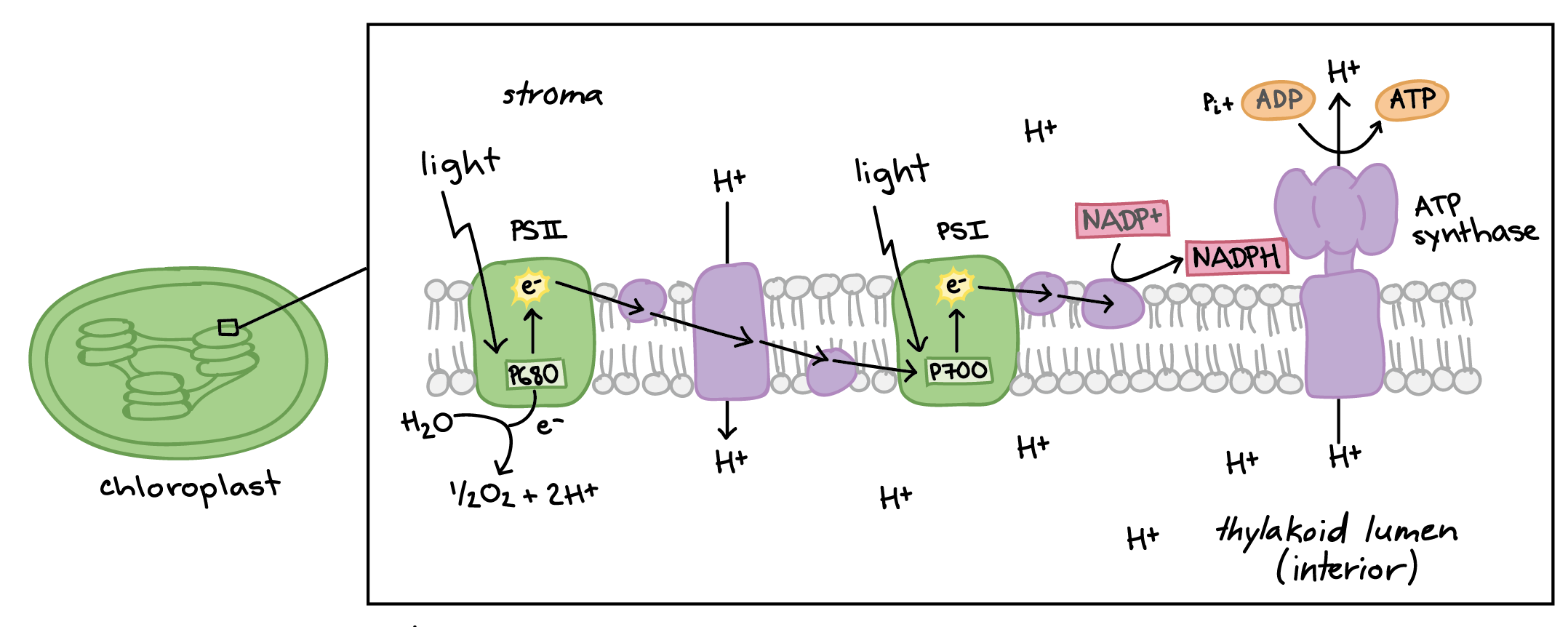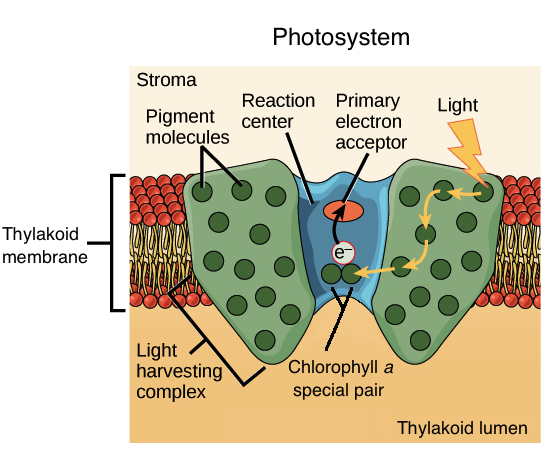Describe the Effect on Chlorophyll Containing Photosystems
A Describe the effect on chlorophyll-containing photosystems when the chlorophyll molecules absorb photons of light. Photosystems are clusters of light-absorbing pigments with some associated moleculesproton hydrogen ion pumps enzymes coenzymes and cytochromes see Chapter 4.
5 2 The Light Dependent Reactions Of Photosynthesis Concepts Of Biology 1st Canadian Edition
Therefore another photon is absorbed by the PSI antenna.

. Photosynthesis occurs in chloroplasts. That energy is transmitted to the PSI reaction center. Light absorbed by antenna complex.
Both photosystems contain many pigments that help collect light energy as well as a special pair of chlorophyll molecules found at the core reaction center of the photosystem. Chlorophyll is a green photosynthetic pigment within the chloroplast grana that absorbs light energy for photosynthesis. The photon causes an electron in the chlorophyll to become excited.
Photosystems are functional and structural units of protein complexes involved in photosynthesis. Photosystem I is an integral membrane protein complex that uses light energy to catalyze the transfer of electrons across the thylakoid membrane from plastocyanin to ferredoxinUltimately the electrons that are. Up to 10 cash back Effects of HT Stress on Chlorophyll Fluorescence Parameters of P.
Photosystem I PSI or plastocyaninferredoxin oxidoreductase is one of two photosystems in the photosynthetic light reactions of algae plants and cyanobacteria. Because the electrons have lost energy prior to their arrival at PSI they must be re-energized by PSI. Chlorophyll fluorescence imaging CFI is a powerful tool to measure photosynthetic efficiency in plants and.
Because the photosystems and the light-harvesting antennae contain many pigments chlorophylls and carotenoids non-photosynthetic mutants often have altered pigmentation ranging from slightly pale to yellow or white chlorina viridis yellow albino white etc. B Identify an appropriate control that the researchers should use when they study the growth and photosynthetic ability of the plant with the mutant enzyme. Together they carry out the primary photochemistry of photosynthesis.
Each photosystem contains about 200 molecules of a green pigment called chlorophyll and about 50 molecules of another family of pigments called carotenoids. The synthesis of chlorophyll pigments from precursor molecules is a process that involves many sequential enzyme-catalyzed steps. When a photon reaches the chlorophyll a in the reaction center that chlorophyll can receive the energy because it absorbs photons of longer wavelengths than the other pigments.
These membranes are located inside. Plants naturally contain high levels of the stress-responsive fluorophore chlorophyll. The two photosystems absorb light energy through proteins containing pigments such as chlorophyll.
Describe the effect on chlorophyll-containing photosystems when the chlorophyll molecules absorb photons of light. Lack of photosynthesis is lethal in homozygous seedlings but they can be rescued if they are grown on. Chloroplasts are chlorophyll-containing organelles found in plants algae and cyanobacteria.
Rubric chlorophyll absorbs mainly red and blue light. The special pair of photosystem I is called P700 while the special pair of photosystem II. Two types of chlorophyll centers have been identified and are associated with two protein complexes identified as Photosystem I and Photosystem II.
Photosystems exist in the membranes of thylakoids. A pigment molecule in the photosystem absorbs one photon a quantity or packet of light energy at a time. A Describe the effect on chlorophyll-containing photosystems when the chlorophyll molecules absorb photons of light.
When chlorophyll molecules absorb photons of light the light energy allows for electrons to be taken from H2O. In the reaction center of the. A photon of light energy travels until it reaches a molecule of chlorophyll.
Researchers studied the growth and. The absorption of light and the transfer of energy and electrons. Photosystems are found in the thylakoid membranes of plants algae and cyanobacteria.
The chloroplasts of flowering land plants typically contain at least two photosynthetic pigments chlorophyll a and chlorophyll b that differ in the wavelengths of light they absorb. Chlorophyll a photochemistry using red light 680 to 700 nm is near universal and is considered to define. Photosystems I and II convert solar energy into the chemical energy that powers life.
An electron in the chlorophyll molecule is excited to a higher energy lever 3. A chlorophyll molecule in the RC absorbs a photon of light 2. Upon absorption of photon by reaction center P680 is excited to.
11 shows the arrangement of photosystems protein complexes containing chlorophyll molecules on the thylakoid membrane of a plant chloroplast. C Scientists claim that a plant that has more than one type. The pigment system II contains chlorophyll-b and some forms of chlorophyll-a.
The oxidized chlorophyll molecule restores its electrons by oxidizing a. A higher energy electron is transferred to a primary electron acceptor 4. Add image later Describe the photoactivation of chlorophyll.
Chloroplasts are found in plant leaves surrounded by guard cells. A very small amount of a special form of chlorophyll-a absorbing at 700 mµ which is known as P 700 however constitutes the reaction centre or trap 1 of pigment system I. The W K V J and M o of both cultivars were higher than those of their respective control after 7 days and 14 days of stress Fig.

Describe The Effect On Chlorophyll Containing Photosystems When The Chlorophyll Molecules Absorb Brainly Com

Light Dependent Reactions Photosynthesis Reaction Article Khan Academy

Light Dependent Reactions Photosynthesis Reaction Article Khan Academy
Comments
Post a Comment